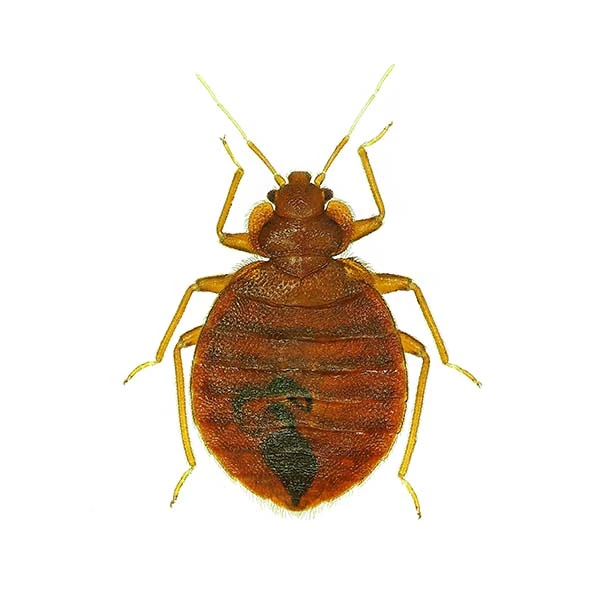Latin Name: Cimex lectularius

Bed bugs are household pests that pose potential health risks to people. These blood-sucking insects are sneaky, hard to find, and dangerous. They hide in beds and feed on humans while they sleep. Humans are not the only target for bed bugs as they also attack warm-blooded animals, including birds. They stay hidden during the day and become active at night when you are fast asleep.
Bed bugs have been associated with humans for over 3300 years and can survive anywhere. They can travel long distances because they quickly latch on clothes, linens, suitcases, etc. That explains why they spread quickly.
Bed bugs (Cimex lectularius) are oval-shaped and small insects of about 5 – 7 mm in length. Before feeding, they are brown and flat, but they become red, swollen, and long after feeding. They have six legs and two antennae. Though they have reduced wing pads, they do not have wings, nor can they fly but can crawl fast.
Their adults are much bigger and visible to human eyes, unlike the nymphs that are smaller in size (about 1.5 mm small – approximately the size of a pinhead) and pale in color until they feed.
Bedbugs are a pest that lives anywhere in the house. You can find them in cracks in house walls, furniture, and textile. However, they mainly breed in large numbers in beds, including the box springs, mattress, and bed frames. They are primarily active at night and can bite any exposed area of the body like the face, neck, arms, and hands. They enter the home undetected through clothing, luggage, couches, beds, and other items. Due to their flat bodies, they can fit in any space. Unlike other ants and insects, bed bugs do not have nests but live-in groups in their hiding places.
They tend to spread quickly in the home because they can move into any crack or protected location. Blood seems to be their favorite place hence poor hygiene is not enough reason for their existence.
Irrespective of the species of bed bugs, they all feed on only blood. However, most of them feed on the blood available to sustain themselves, preferably warm blood. However, some prefer one animal over the other.
Bed bugs can survive without a host for a year or more. They can do this because they are great at conserving moisture at different temperatures. They have a long lifespan because they eat to grow. That is, they eat before they develop into another stage. So, once they are fully matured, they do not need to feed often as they do not need the nutrients to grow anymore.
Bed bugs are easily seen by their small reddish-brown fecal spots on walls, upholstery, and mattresses. They can also be identified by sightings of their eggs, bed bug molt skin, empty eggshells, and the bugs themselves. An easy tell-tale sign of bed bugs is the bites they make on humans’ arms and legs. These bites may be small and itchy. However, the bites are not enough evidence to show their presence.
Other signs of bed bugs infestation include:
You can also check places like inside books, the edge of the carpet, electrical outlets, and radios. You can also check your clothing because they attach themselves to them.
Bedbugs are most active at night because of the opportunity it gives them to bite people. They feed by piercing the skin and drawing blood with their elongated beak. They forage for 3 – 10 minutes before moving away unnoticed. Most of their bites are painless and unnoticed until 3 – 5 days when it starts itching. Their bites are usually around the ankles or any areas that are exposed while sleeping.
If you notice a bedbug infestation, it is best to call a professional because doing it yourself could be difficult. However, there are ways to prevent the existence of bed bugs in your home.
If you suspect these pests are in or around your home, give us a call for a Free Home Inspection!
Bed bugs do not typically hide on your body. They usually hide in cracks and crevices of beds, furniture, and walls.
Bed bugs can be killed with insecticides specifically labeled for bed bugs. Heat treatment and vacuuming can also be effective.
Yes, adult bed bugs are visible to the naked eye, although they are small and flat.
Bed bugs are attracted to warmth, carbon dioxide, and the presence of humans or animals.
No, bed bugs are not caused by poor hygiene. They can infest even the cleanest of homes and hotels.
Bed bugs are drawn out of hiding by the presence of a host, warmth, and carbon dioxide.
Bed bugs are known to dislike extreme heat and certain essential oils, such as lavender and peppermint.
Encasing the mattress and box spring in a bed bug-proof cover and using bed bug interceptors under the legs of the bed can help keep bed bugs away while sleeping.
Bed bugs are nocturnal and are more likely to come out at night when their host is sleeping.
Bed bugs can be picked up from infested furniture, luggage, and clothing. They can also travel between units in apartment buildings and hotels.
Rubbing alcohol can kill bed bugs on contact, but it is not a reliable treatment for an infestation.
Yes, bed bugs can bite at any time, regardless of whether you are sleeping during the day or night.
